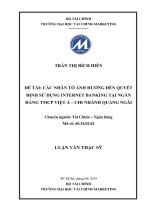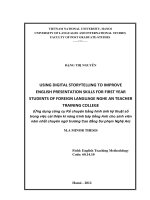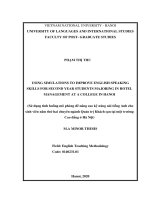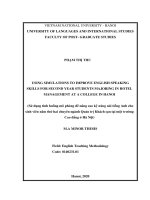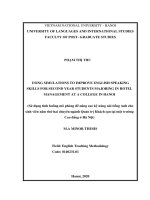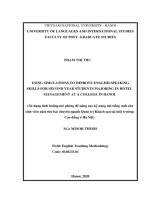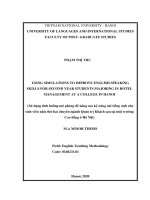Luận văn Thạc sĩ Using simulations to improve English speaking skills for second year students majoring in hotel management at a college in Hanoi
Bạn đang xem bản rút gọn của tài liệu. Xem và tải ngay bản đầy đủ của tài liệu tại đây (585.78 KB, 72 trang )
VIETNAM NATIONAL UNIVERSITY - HANOI
UNIVERSITY OF LANGUAGES AND INTERNATIONAL STUDIES
FACULTY OF POST- GRADUATE STUDIES
PHẠM THỊ THU
USING SIMULATIONS TO IMPROVE ENGLISH SPEAKING
SKILLS FOR SECOND YEAR STUDENTS MAJORING IN HOTEL
MANAGEMENT AT A COLLEGE IN HANOI
(Sử dụng tình huống mơ phỏng để nâng cao kỹ năng nói tiếng Anh cho
sinh viên năm thứ hai chuyên ngành Quản trị Khách sạn tại một trường
Cao đẳng ở Hà Nội)
M.A MINOR THESIS
Field: English Teaching Methodology
Code: 8140231.01
Hanoi, 2020
VIETNAM NATIONAL UNIVERSITY - HANOI
UNIVERSITY OF LANGUAGES AND INTERNATIONAL STUDIES
FACULTY OF POST- GRADUATE STUDIES
PHẠM THỊ THU
USING SIMULATIONS TO IMPROVE ENGLISH SPEAKING
SKILLS FOR SECOND YEAR STUDENTS MAJORING IN HOTEL
MANAGEMENT AT A COLLEGE IN HANOI
(Sử dụng tình huống mơ phỏng để nâng cao kỹ năng nói tiếng Anh cho
sinh viên năm thứ hai chuyên ngành Quản trị Khách sạn tại một trường
Cao đẳng ở Hà Nội)
M.A MINOR THESIS
Field: English Teaching Methodology
Code: 8140231.01
Supervisor: Dr. Trần Thị Thu Hiền
Hanoi, 2020
DECLARATION
The work provided in this thesis, unless otherwise referenced, is the
researcher‟s own work, and has not been submitted elsewhere for any other
degree or qualification.
Hanoi, 2020
Signature
Pham Thi Thu
Approved by
SUPERVISOR
Date: 18th Sept 2020
i
ACKNOWLEDGEMENTS
I would like to express my sincerest gratitude to a number of people who have
given me significant help, encouragement, and support in the completion of
my thesis.
In the first place, I would like to express my deep and sincere gratitude to my
supervisor, Dr. Tran Thi Thu Hien for her valuable time, patience, guidance,
advice, correction, and encouragement throughout the stages of the thesis
writing. Without her guidance and support, this study would not have been
completed.
My sincere thanks also go to all my lecturers and in Faculty of Post-graduate
Studies, University of Languages and International Studies, Vietnam National
University, Hanoi for their interesting lectures which have inspired me to
conduct this research.
Besides, I would like to thank my colleagues and my students at Hanoi
Tourism College who have participated in this research and helped me during
my study.
Last but not least, I would like to send my special thanks to my parents, my
husband and my children who encourage and share the hardship with me.
Their great encouragement and love have helped me to overcome the
difficulties in the study.
ii
ABSTRACT
This research aimed at using simulation technique to improve speaking skills
in English for specific purposes for students majoring in Hotel Management.
It was an action research study with both qualitative and quantitative data
collected from second-year students majoring in Hotel Management at a
college in Hanoi. The qualitative data were collected by delivering
questionnaires, interviewing the students. Meanwhile, the quantitative data
were collected through assessing the students‟ speaking performance by
comparing the results of the pre-test and the post-test. The procedure of this
action research consisted of initiation, preliminary investigation, hypothesis,
intervention, evaluation, and dissemination.
The research has shown that using simulation technique could successfully
improve the students‟ speaking competence in general and in some important
aspects related to speaking skills including fluency, vocabulary and
pronunciation. Besides, difficulties faced by students in using simulations are
also recognized.
iii
LIST OF ABBREVIATIONS
AR
Action Research
Com
Comprehension
ESP
English for Specific Purposes
Pron
Pronunciation
Vocab
Vocabulary
iv
LISTS OF CHARTS, FIGURES AND TABLES
Chart 4.1. Overall mean score of the pre-test and the post-test ..................... 36
Chart 4.2. Scores of students‟ pre-test and post-test ...................................... 37
Figure 2.1. The structure of a simulation (Sturtridge, 1977) ......................... 18
Figure 3.1: Detailed action research mode (Susman 1983) ........................... 24
Figure 3.2: Cyclical AR model based on Kemmis and Mc Taggart (1988). . 26
Table 2.1. Simulations vs Role plays (Bambrough, 1994) ............................ 17
Table 4.1. The pre-test results ........................................................................ 34
Table 4.2. The pre-test vs. the post-test results .............................................. 36
Table 4.3. Pronunciation improvement .......................................................... 38
Table 4.4. Fluency improvement ................................................................... 38
Table 4.5. Vocabulary improvement .............................................................. 39
Table 4.6. Students‟ improvement of each speaking indicator ...................... 39
Table 4.7. Confidence improvement .............................................................. 40
Table 4.8. Students‟ attitude towards simulations. ........................................ 41
Table 4.9. Preparation for the future job. ....................................................... 42
Table 4.10. Difficulties in performing in simulations .................................... 43
Table 4.11. Difficulties in cooperating with a partner ................................... 44
v
TABLES OF CONTENTS
DECLARATION ............................................................................................. i
ACKNOWLEDGEMENTS ........................................................................... ii
ABSTRACT ................................................................................................... iii
LIST OF ABBREVIATIONS ...................................................................... iv
LISTS OF CHARTS, FIGURES AND TABLES ........................................ v
CHAPTER I: INTRODUCTION ................................................................. 1
1. Rationale for the study ................................................................................. 1
2. Aim and objectives of the study ................................................................... 2
3. Research questions ....................................................................................... 2
4. Scope of the study ........................................................................................ 2
5. Methods of the study .................................................................................... 3
6. Significance of the study .............................................................................. 3
7. Structural organization of the thesis ............................................................. 4
CHAPTER II: LITERATURE REVIEW ................................................... 5
2.1. Speaking skills .......................................................................................... 5
2.1.1. Definition of speaking skills .................................................................. 5
2.1.2. Characteristics of speaking skills ........................................................... 6
2.1.3. Characteristics of a successful speaking activity ................................... 8
2.1.4. Teaching speaking .................................................................................. 9
2.1.5. Speaking Assessment ........................................................................... 10
2.2. Simulations .............................................................................................. 10
2.2.1. Definition of simulations in language teaching and learning. ............. 10
2.2.2. Characteristics of simulations .............................................................. 11
2.2.3. Benefits of simulations ......................................................................... 12
2.2.4. Limitations of simulations ................................................................... 14
2.2.5. Simulations in teaching speaking skills ............................................... 16
vi
2.3. Previous studies ....................................................................................... 19
2.4. Summary ................................................................................................. 20
CHAPTER III: METHODOLOGY ........................................................... 21
3.1. Restatement of research questions .......................................................... 21
3.2. Research setting ...................................................................................... 21
3.3. Participants .............................................................................................. 22
3.4. Research method ..................................................................................... 23
3.4.1. An overview of action research ........................................................... 23
3.4.2. Action research cycle ........................................................................... 24
3.4.3. Rationale for the use of an action research .......................................... 27
3.5. Research procedure ................................................................................. 27
3.5.1. Step 1: Initiation (Week 1) ................................................................... 28
3.5.2. Step 2: Preliminary investigation (Week 2) ......................................... 28
3.5.3. Step 3: Hypotheses (Week 3) ............................................................... 28
3.5.4. Step 4: Intervention (Week 4 -14) ........................................................ 29
3.5.5. Step 5: Evaluation (Week 15) .............................................................. 29
3.5.6. Step 6: Dissemination .......................................................................... 30
3.6. Data collection instruments .................................................................... 30
3.6.1. Pre-test and post-test (Appendix 1&2) ................................................ 30
3.6.2. Questionnaire (Appendix 4) ................................................................. 31
3.6.3. Interview ............................................................................................... 32
3.7. Data analysis ........................................................................................... 32
3.8. Summary ................................................................................................. 33
CHAPTER IV: FINDINGS AND DISCUSSIONS ................................... 34
4.1. Students‟ improvement in speaking skills. ............................................. 34
4.1.1. Students‟ general improvement ........................................................... 34
4.1.2. Students‟ improvement in some aspects of speaking skills. ................ 37
4.2. Students‟ perceptions of the benefits of simulations to their learning of
vii
speaking .......................................................................................................... 40
4.2.1. Students‟ confidence improvement ...................................................... 40
4.2.2. Perception improvement ...................................................................... 41
4.2.3. Students‟ perceived benefits of simulations to their future jobs .......... 42
4.3. Students‟ perceived challenges in performing in simulations ................ 43
4.3.1. Difficulties in performing some situations .......................................... 43
4.3.2. Lack of practical experience ................................................................ 43
4.3.3. Affective factors ................................................................................... 44
4.4. Discussion ............................................................................................... 44
CHAPTER V: CONCLUSION ................................................................... 46
5.1. Recapitulation ......................................................................................... 46
5.2. Implications ............................................................................................. 46
5.2.1. Setting the time effectively for each simulation. ................................. 46
5.2.2. Delivering clear and careful explanations about a simulation. ............ 47
5.2.3. Employing simulated situations suitable for students‟ interest. .......... 47
5.3. Limitations of the research ...................................................................... 47
5.4. Recommendations and suggestions for future research .......................... 47
REFERENCES ............................................................................................. 49
APPENDICES ................................................................................................. I
APPENDIX 1: PRE-TEST ............................................................................. I
APPENDIX 2: POST-TEST ..........................................................................II
APPENDIX 3: THE SPEAKING TEST RATING SCALE ..................... III
APPENDIX 4: QUESTIONNAIRE ............................................................. V
APPENDIX 5: INTERVIEW ..................................................................... VII
APPENDIX 6: LESSON PLAN SAMPLE ............................................. VIII
viii
CHAPTER I: INTRODUCTION
1. Rationale for the study
Language cannot be separated from human activities. People share their
thoughts, feelings, experiences, and many things with others by using
language. Language becomes the main instrument of communication because
people use language to conduct communication in their every social
interaction. English is one of languages that becomes international language.
It means that English is used by many people around the world to
communicate or deliver something, includes in teaching and learning process.
In Vietnam, English becomes one of important subjects in national
examination for high school level and a compulsory subject at universities or
colleges. Therefore, mastering English is very important. However, most of
students remain unable to use English meaningfully, especially they remain
insufficient in their ability to speak English.
Thus, English teachers play an important role in the success of teaching and
learning activity. They must have a good method to make teaching and
learning process in speaking skills more enjoyable and meaningful. The
teachers must be able to make the students participate actively in speaking.
English teachers should use appropriate approach, design, and procedures.
Applying good teaching methods can make teaching and learning process
more efficient.
With purpose to increase the effectiveness of teaching speaking skills to
students at a college in Hanoi, the researcher applied simulation technique in
teaching English speaking skills. It is hoped to help students improve their
ability to speak English in real-world situations and have a better overview of
the job they will take in the future.
1
2. Aim and objectives of the study
The research aims to investigate the use of simulation technique to
improve speaking skills among the second-year students in the Hotel
Management Department at a college in Hanoi. The objectives of the study
are summarized as follows:
1. To investigate the effectiveness of applying simulations in teaching
English speaking skills.
2. To find out the students‟ perception of the benefits of simulations to
their development of speaking skills.
3. To find out challenges facing students in doing simulations in
speaking lessons.
3. Research questions
1. How have the students‟ English speaking skills been improved after
using simulations?
2. What do the students perceive of the benefits of simulations to their
development of speaking skills?
3. What are the challenges facing students in doing simulations as
perceived by themselves?
4. Scope of the study
The focuses of the study are to investigate the effectiveness of using
simulation technique in teaching English speaking, the students‟ perceived
benefits of simulations and the challenges facing students in the performance
in simulations in speaking lessons. The researcher carried out an action
research study on the topic of using simulations to improve English speaking
skills for second-year students majoring in Hotel Management at a college in
Hanoi for a fifteen-week period.
The research was conducted on second-year students in the Hotel
2
Management Department at a college in Hanoi. Regarding its scope, the study
only aims at justifying the effectiveness, the students‟ perceived benefits of
simulations and the challenges of using simulations in speaking classes. Other
aspects of English skills would not be investigated.
5. Methods of the study
This study was carried under both qualitative and quantitative approach, with
the use of several data collection instruments, namely questionnaires, tests
and interviews. The data are then analyzed to figure out the findings of the
research.
The combination of different instruments in this research would help to gain
reliable data and help the researcher have a close investigation into the
problems that the students may find challenging or interesting.
6. Significance of the study
There are some advantages that can be taken from this research. The
following presents some possible ways:
6.1 Practical significance
For the teachers, the result of this research is expected to provide an
alternative technique to teach speaking skills for students in ESP classes. It is
also expected to motivate the teachers to be more creative and the students
will be more enthusiastic in learning English speaking lessons. It can also be
used as a reference for those who want to conduct a research in English
teaching and learning by using simulations.
For the researcher, the result of this research can develop her experience
related to her knowledge in doing research and teaching English, especially
teaching speaking skills.
For the students, the result of this research is expected to give them new
experience in English learning, especially in learning speaking skills so they can
be more motivated to develop their communication skills in their future job.
3
6.2. Theoretical significance
Theoretically, the result of this study is expected to give understanding about
the theory related to the implementation of simulation technique in teaching
speaking skills, especially in the field of ESP.
7. Structural organization of the thesis
This thesis is divided into five chapters: Chapter I: Introduction, Chapter II:
Literature Review, Chapter III: Methodology, Chapter IV: Findings and
Discussion and Chapter V: Conclusion
Chapter I: Introduction
This part provides an overview of the study such as rationale for the study,
aim and objectives of the study, research questions, methods of the study and
significance of the study.
Chapter II: Literature Review
This chapter presents general background knowledge related to teaching
speaking, simulations and using simulations in teaching speaking skills in
ESP environment. Previous studies related to the topic have also been
reviewed to back up the research.
Chapter III: Methodology
This chapter describes participants and instruments of the study, research
methods as well as procedures employed to carry out the research.
Chapter IV: Findings and Discussion
This chapter presents the data collected in details and then analyses major
patterns found in the data collected according to the research questions.
Chapter V: Conclusion
This part summarizes the main issues discussed in the paper, several pedagogical
recommendations concerning the research topic, limitations of the research, as
well as some recommendations and suggestions for further studies.
Following this chapter are the References and Appendices.
4
CHAPTER II: LITERATURE REVIEW
This chapter is concerned with the theoretical background of the study which
includes an overview of teaching and learning speaking skills, characteristics
of speaking skills, teaching speaking, speaking assessment, simulations,
characteristics of simulations, its benefits and limitations.
2.1. Speaking skills
2.1.1. Definition of speaking skills
There are numerous definitions of the word „speaking‟ that have been
suggested by the researchers in language learning. According to Chaney
(1988), speaking is „the process of building and sharing meaning using verbal
and non-verbal symbols, in a variety of contexts. Bygate (1987) defined
speaking as the production of auditory signals to produce different responses
in listeners. It is regarded as combining sounds systematically to form
meaningful sentences. Sharing the same viewpoint, Nunan (2003) considers
„speaking is the productive oral skill. It consists of producing systematic
verbal utterance to convey meaning‟.
Brown (1994) and Burns and Joyce (1997) on the other hand defines speaking as
an interactive process of making meaning that includes producing, receiving, and
processing information. Similarly, Harmer (2001) states „effective speaking
involves a good deal of listening, an understanding of how the other parties are
feeling, and knowledge of how linguistically to take turns.
Speaking is one of the four abilities in the language activities. It is important
to convey in the communication. According to Cameron (2001), speaking is
the active use of language to express meaning so that other people can make
sense of them. It means that speaking consists of producing systematic verbal
utterances to convey meaning which make other people know what we are
talking about clearly. Therefore, it is often spontaneous, open-ended, and
5
evolving, but it is not completely unpredictable.
From the explanation above, it can be concluded that speaking is a process to
convey and share ideas and feelings orally. This paper follows the idea that
speaking involved such aspects as accuracy, appropriateness, fluency and
vocabulary building since all of those elements need to be mastered by the
students in the English learning progress.
2.1.2. Characteristics of speaking skills
According to Mazouzi (2013) fluency and accuracy are crucial elements of
communicative approach. So, learners „activities should be designed based on
an equivalence between fluency and accuracy achievement. Classroom
practice can help learners improve their communicative competence.
The first characteristics of speaking skills is fluency. Developing learners
„fluency is the main aims of teachers in teaching speaking skills. According to
Hughes (2002) fluency is the learners „ability to speak in understandable way
in order not to break down communication because listeners may lose their
interest. Sharing the same viewpoint, Hedge (2000) states that fluency is the
learners „ability to respond coherently by connecting the words and phrases,
pronouncing the sounds clearly, and using stress and intonation.
The second characteristic of speaking performance is accuracy. Learners seek
more to be fluent and they forget about being accurate. Therefore, accuracy
should be emphasized in teaching process. According to Mazouzi (2013)
learners should pay enough attention to the exactness and the completeness of
language form when speaking such as focusing on grammatical structures,
vocabulary, and pronunciation. Without structuring accurate speech, speakers
will not be understood, and their interlocutors will lose interest if they
perform incorrect utterances each time. Achieving accuracy in terms of
grammar refers to the range and the appropriate use of the learners
6
„grammatical structure that involves the length and the complexity of the
utterances in addition to the ability to use the subordinating clauses.
(Thornbury, 2005). Gaining accuracy in terms of vocabulary means to select
appropriate words in suitable contexts. Students often have difficulties when
they use similar words or expressions which do not carry the same meaning in
all contexts.
Thornbury (2005) stated that pronunciation is the lowest level of knowledge
learners typically pay attention to it. Learners, who want to develop speaking
skills should practice pronunciation overall. Learners should also know the
stress, intonation, and pitch. All these issues give them extra information
about how to speak English fluently and effectively.
According to Syakur (2007), there are at least five components of speaking
skills concerned with comprehension, grammar, vocabulary, pronunciation,
and fluency. In particular,
- Comprehension, for oral communication, certainly requires a subject to
respond, to speech as well as to initiate it. Comprehension is the ability
of understanding the speakers‟ intention and general meaning. It means
that comprehensibility focuses on the students‟ understanding of the
conversation. It is also included the understanding of what the speakers
wants to deliver.
- Grammar is necessary for students to arrange a correct sentence in
conversation.
- Vocabulary is concerned with choice of words which is sufficient to
convey the meaning. “Vocabulary, as one of the knowledge areas in
language, plays a great role for learners in acquiring a language”
(Cameron, 2001). It means vocabulary is the first thing that learners
must know before making a sentence. The learners need to memorize
7
and know the meaning of that words. So, the more vocabulary learners
have, the more easily the learners communicate.
- Pronunciation is the student‟s ability to produce clearer language when
they speak. It deals with the phonological process. Pronunciation
becomes important because it gives meaning to what is being said.
Wrong pronunciation may cause misunderstanding or people involved
in a conversation are offended. (Thornbury, 2005)
- Fluency can be defined as the ability to speak fluently and accurately.
Fluency is the ease and speed of the flow of the speech. (Haris, 1987).
Fluency refers to the smoothness of flow which sounds, syllables,
words, and phrases are joined together when speaking
2.1.3. Characteristics of a successful speaking activity
The goal of teaching speaking is communicative efficiency. Learners should
be able to make themselves understood, using their current proficiency to the
fullest. They should also observe the social and cultural rules that apply in
each communication situations. According to Ur (1999, p.12), there are some
characteristics of a successful speaking activity:
1. Learners talk a lot. As much as possible of the period of time allotted to the
activity is in fact occupied by learner talk. This may seem obvious, but often
most time is taken up with teacher talk or pauses.
2. Participation is even. Classroom discussion is not dominated by a minority
of talkative participants: all get a chance to speak, and contributions are fairly
evenly distributed.
3. Motivation is high. Learners are eager to speak because they are interested
in topic and have something new to say about it, or just because they want to
contribute to achieving a task objective.
4. Language is of an acceptable level. Learners express themselves in
8
utterance that is relevant, easily comprehensive to each other, and of an
acceptable level of language accuracy.
From his idea, it can be seen that the most prominent features of a successful
speaking activity are the maximization of learners‟ speaking time, equal
chance for every student to speak, the learners‟ willingness to speak and the
mutual understanding between the interlocutors. Teachers must keep these
features in mind when designing speaking tasks for students.
2.1.4. Teaching speaking
Spratt, Pulverness and William (2005) state that teaching speaking means
developing learners „speaking skills by focusing regularly on particular
aspects of speaking (fluency, pronunciation, grammatical accuracy, and body
language). Brown (2001) states that teaching means showing or helping
someone to do something, giving instructions, guiding in the study of
something, providing with the knowledge, causing to know or to understand.
According to Nunan (2003), teaching speaking is to teach language learners to:
- Produce the English speech sounds and sounds patterns.
- Use words and sentence tress, intonation patterns and the rhythm of the
second language.
- Select appropriate words and sentences according to the proper social
setting, audience, situation, and subject matter.
- Organize their thoughts in a meaningful and logical sequence.
- Use language as a means of expressing values and judgements.
- Use the language quickly and confidently with few unnatural pauses,
which is called fluency.
In short, whenever the terms speaking skills and teaching speaking skills are
mentioned in this thesis, they refer to all above-listed aspects. Teaching
speaking skills involves teaching these features as well.
9
2.1.5. Speaking Assessment
Assessment plays an important role in the process of teaching and learning.
Assessment provides information for the teachers about the strengths and the
weaknesses of their teaching as the students' achievement also represents
teachers' teaching quality. Meanwhile, assessment provides information
related to their achievement. It can also motivate them to prepare their best
performance in accomplishing assignments or tasks.
In this study, the learners‟ speaking performances were assessed using a
scoring rubric proposed by Harris (1974) (Appendix 3). The aspects of
speaking which scored were pronunciation, grammar, vocabulary, fluency and
comprehension.
2.2. Simulations
2.2.1. Definition of simulations in language teaching and learning.
The use of simulations in language teaching which is gaining increasing
popularity especially with the advent of “communicative methodology” is an
extremely valuable method. Simulation is a way of “declassrooming the
classroom” by bringing real world communication to classroom (Salies,
2002a). Thus the students are given an environment similar to a real life
context to use the language meaningfully.
SAGSET (Society for Advancement of Games and Simulations in Education
and Training) defines simulations as “teaching and learning methods in which
participants are directly involved in making decisions and learning from the
outcomes of these. Their active, student centered nature means that they are
memorable and highly motivating. They enable the exploration of the
complex nature of the real world and interdisciplinary, interacting subjects as
well as the more basic needs of understanding, doing and skills practice.”
Simulations can be defined as a “structured set of circumstances that mirror
10
real life and participants act as instructed” (Javid, 2013). In other words,
simulations can be defined as the act of initiating the behavior of some
situation or some process by means of something suitably analogous.
In the case of this study, the view of simulations is that they provide a way of
creating a rich communicative environment (a representation of reality) where
students actively become a part of some real-world systems and function
according to predetermined roles as members of a group.
2.2.2. Characteristics of simulations
In his book “Simulation in Language Teaching” (1982), Jones defines
simulations as a “reality of function in a simulated and structured
environment”.
This definition shows three essential elements in simulations:
- A reality of function – participants are assigned roles and are told they must
fully accept them both mentally and behaviorally as if they were those people.
- A simulated environment – a realistic setting constructed to enhance roleacceptance by utilizing a variety of realia.
- A structure based on explicit “fact”– the whole action is built around a set
of problems or tasks, thus following the task-based model of teaching.
Participants must step inside the function mentally and behaviorally to fulfill
their duties and responsibilities in the situation (Jones, 1982). The most
important part of simulations is having participants accept the reality of
function (role and duties) fully, not thinking as students but taking the role;
otherwise the simulation simply will not work. Acceptance of the reality of
function means that a participant who has the function of doctor must
examine the patient, communicating effectively to do the job. The role of
students in simulations, therefore, is (i) taking the functional roles such as
reporter, survivor, or customer as a participant, (ii) stepping into the event,
11
and (iii) shaping the event, carrying out their duties and responsibilities. (cited
on Lyu, 2006, p.13)
In simulations, a provided environment must be simulated. In order to fulfill
the essential condition of being a simulated environment, there must be no
contact between the participants and the world outside of the classroom
(Jones, 1982, p.5). In other words, when an office in a company is the setting
for a simulation, we do not provide a real office or a building, yet we create a
simulated environment representing the office that is outside of the classroom
by arranging some desks with other props like a computer, office materials,
and so on. Likewise, if we need a door, we can provide a simulated
environment by putting two chairs together. One thing that we need to keep in
mind is that only the environment is simulated, but the behavior of a
participant is real. (cited on Lyu, 2006, p.13)
It is important that the essential “facts” of the simulation environment are
provided, not invented by the participants, to preserve reality of function
(Jones, 1982). Without structure, it is not a simulation because there is no
reality of function.
2.2.3. Benefits of simulations
Simulations are widely used in the classrooms because they are an ideal
technique for language teaching and learning, providing a life-like
environment which promotes learners to use the language creatively and
communicatively. In terms of advantages, scholars have believed that
simulations:
2.2.3.1. Provide a real communicative activity
Simulations are perfect activities that offer ample opportunities for learners to
communicate in the target language. As Jones (1982) mentions, simulations
provide the participants with the mutual need to communicate and the need is
12
inherent in the activity. In other words, participants naturally communicate in
order to fulfill the role or solve the problem in simulations. Participants in
simulations continually interact exchanging thoughts and negotiating
meanings as they take roles and try to fulfill the duty. Jones (1982) depicts a
good simulation as a nuclear power breeder reactor. As a nuclear power
breeder reactor produces its own fuel, communication in a good simulation
leads to more communication, ideas generate ideas, talk leads to thought, and
thought leads to more talk (Jones, 1982).
2.2.3.2. Motivate students
Motivation is inherent in a simulation (Jones, 1982). It is self-generated since
motive arises out of function, the duties, the responsibilities, and the
circumstances in which the participants find themselves (Jones, 1982).
As Jones (1982) states, motivation from function and duty is an essential
ingredient in a simulation. Therefore, no effort to motivate learners will be
necessary as long as learners accept the reality of their functions. Motivation
may also come from the emotional satisfaction or the pleasure of power to make
decisions and the enjoyment of interactive excitement. (cited on Lyu, 2006)
2.2.3.3. Develop students' communicative competence
Simulation enhances students‟ communicative competence. Simulation has a
magic ingredient (Jones, 1982), one that provokes talk, since communication,
function and duties are always real to the learner, even if the simulation is set
more than one thousand years into the future. The methodology offers the
opportunity to enhance communicative language ability, together with
cultural literacy of the language.
2.2.3.4. Improve integration of skills
Another one of benefits of simulations as a teaching strategy in language
classroom is the integration of the four skills in addition to the enhanced
13
use of vocabulary (Hyland, 2009). Extensive reading is required of
students during their preparation for the simulation. Students become
immersed in both written and auditory texts in English. Students also
develop their ability to listen and comprehend aurally and answer and
negotiate convincingly during discussions (Salies, 2002a). When students
orally discuss the simulated topics, their vocabulary gets exercised. Being
exposed to various simulated topics and the roles the simulations involve
students learn new terms and role specific jargon.
2.2.3.5. Encourage active participation
Simulations are one of few classroom activities that involve a high level of
student participation (Hyland, 2009). The high level of participation gets
learners engaged in the task and provides opportunities for student-student
interaction.
2.2.3.6. Prepare students for real life and unpredictability
Since learners have experienced various realistic situations through
simulations, they will feel more comfortable and more prepared in
unrehearsed situations. Therefore, through the realistic experiences in
simulations, learners can gain confidence when communicating with others in
a real situation. It is not the “I‟ve read it, so now I know it” type of
confidence: It is the “I‟ve done it, so I can do it” confidence (Jones, 1982 (as
cited on Lyu, 2006)
2.2.4. Limitations of simulations
Although simulations seem effective in teaching speaking skills, drawbacks in
simulations are inevitable.
2.2.4.1. Difficulties in monitoring activities
There is no teacher inside simulation activities. Participants are responsible
for solving assigned problems and making decisions. (Lyu, 2006). With so
14
much activity both physical and verbal going on, it is sometimes difficult for
the teacher to monitor a student's performance. There is the fear among
teachers that the students are having too much fun and that no learning is
taking place.
2.2.4.2. Selection of suitable simulations
Some criteria will have to be set before the selection of the appropriate
simulations. Factors to be considered include the language level of the
learners, costs of purchasing or making simulations sets, its relevance to the
students and so on.
2.2.4.3. Embarrassment
In some situations, especially among adult learners, simulation activities
cause a lot of embarrassment, awkwardness, and very little spontaneous
language use. The choice of appropriate roles for different students is thus
very important.
2.2.4.4. Encouragement of incorrect forms
The teacher‟s role in simulations is to be a good controller. Jones (1982)
likens teachers‟ role to a traffic controller: “a person who controls the flow of
traffic, tries to avoid bottlenecks, but does not tell individual motorists the
direction of their journeys.” Thus, the teacher is not encouraged to correct
mistakes immediately so as not to discourage students, this provides
opportunities for learners to produce and practice ungrammatical and
inappropriate forms.
2.2.4.5. Difficulties in timing lessons
The teacher must spend a lot of time in preparation work especially for
simulations. The teacher is not able to predict the amount of class time that
will be taken to carry out the activity since the ability of each class varies.
15
